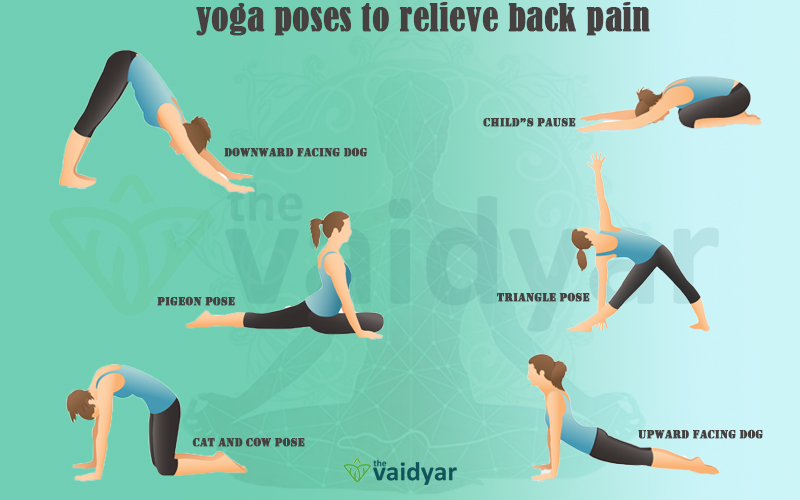
Yoga has long been recognized for its ability to enhance flexibility, strength, and mental well-being. For those suffering from back pain, incorporating yoga into a daily routine can provide significant relief and help prevent future issues. This blog will explore specific yoga poses that alleviate back pain, the overall benefits of yoga for strengthening and flexibility, and tips for beginners who are just starting their journey toward better back health.
Specific Yoga Poses that Alleviate Back Pain
1. Child’s Pose (Balasana)
This gentle stretch helps to elongate the spine and relieve tension in the back.
How to Do It:
- Start on your hands and knees, with your knees wide apart.
- Sit back on your heels and reach your arms forward, lowering your forehead to the mat.
- Hold for 30 seconds to a minute, breathing deeply.
2. Cat-Cow Stretch (Marjaryasana-Bitilasana)
This dynamic movement warms up the spine and helps relieve back stiffness.
How to Do It:
- Start on your hands and knees in a tabletop position.
- Inhale as you arch your back (Cow Pose), lifting your head and tailbone.
- Exhale as you round your back (Cat Pose), tucking your chin and pelvis.
- Repeat for 5-10 cycles.
3. Downward-Facing Dog (Adho Mukha Svanasana)
This pose stretches the entire back and helps improve overall strength and flexibility.
How to Do It:
- Start on your hands and knees.
- Lift your hips up and back, straightening your legs and forming an inverted V-shape.
- Press your heels toward the floor and relax your head between your arms.
- Hold for 30 seconds to 1 minute.
4. Sphinx Pose
A gentle backbend that opens up the chest and strengthens the lower back.
How to Do It:
- Lie on your stomach with your forearms on the ground and elbows under your shoulders.
- Press into your forearms, lifting your chest off the floor while keeping your hips grounded.
- Hold for 20-30 seconds, focusing on your breath.
5. Bridge Pose (Setu Bandhasana)
This pose strengthens the back, glutes, and legs while providing a stretch to the spine.
How to Do It:
- Lie on your back with your knees bent and feet flat on the floor, hip-width apart.
- Press your feet into the ground as you lift your hips toward the ceiling.
- Hold for 20-30 seconds, then slowly lower your hips back down.
Benefits of Yoga for Strengthening and Flexibility
Strengthening
Yoga emphasizes the development of core strength, which is crucial for supporting the spine and reducing back pain. Many yoga poses engage the abdominal muscles and promote stability, leading to improved posture and alignment.
Flexibility
Regular practice of yoga enhances flexibility in the spine, hips, and legs, reducing tension and tightness that can contribute to back pain. Increased flexibility allows for a greater range of motion in daily activities and can help prevent injuries.
Mind-Body Connection
Yoga promotes mindfulness and relaxation, which can help manage stress and reduce tension in the body. The focus on breathing and meditation during yoga practice encourages a holistic approach to health, which is beneficial for those dealing with chronic pain.
Tips for Beginners Starting Yoga for Back Health
1. Start Slowly
If you’re new to yoga, begin with gentle classes or online tutorials specifically designed for beginners or those with back pain. Gradually build your strength and flexibility over time.
2. Listen to Your Body
Pay attention to how your body feels during each pose. If something doesn’t feel right or causes pain, ease out of the pose or modify it. It’s essential to practice yoga with awareness and respect for your limits.
3. Use Props
Don’t hesitate to use yoga props like blocks, straps, or bolsters to support your practice. These tools can help you achieve proper alignment and make poses more accessible.
4. Focus on Breathing
Incorporate deep breathing into your practice. Focusing on your breath can enhance relaxation and help relieve tension, making your practice more effective for back pain relief.
5. Consider a Class
Joining a beginner yoga class, either in-person or online, can provide guidance and motivation. Instructors can offer modifications and tips tailored to your needs, ensuring a safe and enjoyable experience.
Conclusion
Yoga offers a holistic approach to alleviating back pain, promoting strength, flexibility, and overall well-being. By incorporating specific poses into your routine, you can experience significant relief and improve your spinal health. If you’re new to yoga, follow the tips for beginners and listen to your body as you embark on this transformative journey. With patience and practice, you can find balance and harmony in your body, paving the way for a pain-free future.

